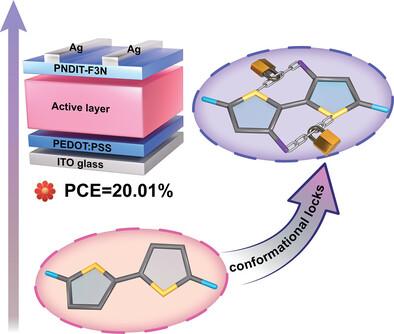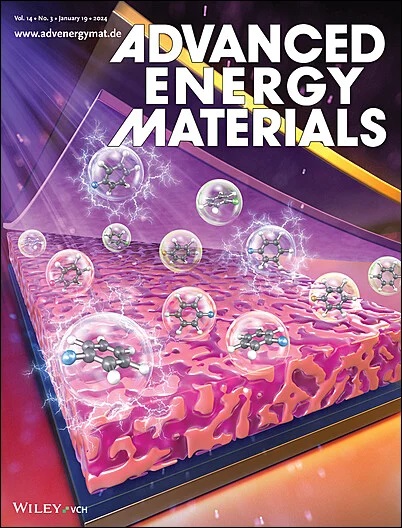Achieving 20% Efficiency in Organic Solar Cells Through Conformationally Locked Solid Additives
IF 24.4
1区 材料科学
Q1 CHEMISTRY, PHYSICAL
引用次数: 0
Abstract
Volatile solid additives (VSAs) have emerged as one of the most effective strategies for optimizing the active layer morphology of organic solar cells (OSCs). In this study, two VSAs, HBT-1 and HBT-2, are designed and synthesized to investigate the effect of the VASs’ conformation on the photovoltaic performances. Compared to HBT-1, HBT-2 incorporates internal noncovalent conformational locks (NoCLs), resulting in reduced conformational disorder, improved molecular planarity, and enhanced crystallinity. These features significantly influence the intermolecular packing of both donor and acceptor materials in the active layer, which can facilitate charge transport and reduce charge recombination. Consequently, the D18:L8-BO:PY-C11 OSCs utilizing the HBT-2 additive achieved an impressive efficiency of 20.01%, markedly higher than devices fabricated without additives (17.83%) and those processed with HBT-1 (18.76%). Furthermore, HBT-2 demonstrated excellent compatibility across multiple systems. This work underscores the NoCL strategy as a straightforward and effective approach for designing VSAs for high performance OSCs.

通过构象锁定固体添加剂实现有机太阳能电池20%的效率
挥发性固体添加剂(VSAs)已成为优化有机太阳能电池(OSCs)活性层形态的最有效策略之一。本研究设计并合成了两个VASs, hpt -1和hpt -2,以研究VASs的构象对光伏性能的影响。与HBT-1相比,HBT-2包含内部非共价构象锁(nocl),从而减少了构象紊乱,改善了分子平面度,增强了结晶度。这些特征显著地影响了活性层中供体和受体材料的分子间填充,从而促进了电荷的传输,减少了电荷的重组。因此,使用hpt -2添加剂的D18:L8-BO: y - c11 OSCs的效率达到了20.01%,显著高于未添加添加剂的器件(17.83%)和使用hpt -1加工的器件(18.76%)。此外,HBT-2表现出跨多个系统的出色兼容性。这项工作强调了NoCL策略是为高性能osc设计vsa的一种简单有效的方法。
本文章由计算机程序翻译,如有差异,请以英文原文为准。
求助全文
约1分钟内获得全文
求助全文
来源期刊

Advanced Energy Materials
CHEMISTRY, PHYSICAL-ENERGY & FUELS
CiteScore
41.90
自引率
4.00%
发文量
889
审稿时长
1.4 months
期刊介绍:
Established in 2011, Advanced Energy Materials is an international, interdisciplinary, English-language journal that focuses on materials used in energy harvesting, conversion, and storage. It is regarded as a top-quality journal alongside Advanced Materials, Advanced Functional Materials, and Small.
With a 2022 Impact Factor of 27.8, Advanced Energy Materials is considered a prime source for the best energy-related research. The journal covers a wide range of topics in energy-related research, including organic and inorganic photovoltaics, batteries and supercapacitors, fuel cells, hydrogen generation and storage, thermoelectrics, water splitting and photocatalysis, solar fuels and thermosolar power, magnetocalorics, and piezoelectronics.
The readership of Advanced Energy Materials includes materials scientists, chemists, physicists, and engineers in both academia and industry. The journal is indexed in various databases and collections, such as Advanced Technologies & Aerospace Database, FIZ Karlsruhe, INSPEC (IET), Science Citation Index Expanded, Technology Collection, and Web of Science, among others.
 求助内容:
求助内容: 应助结果提醒方式:
应助结果提醒方式:


